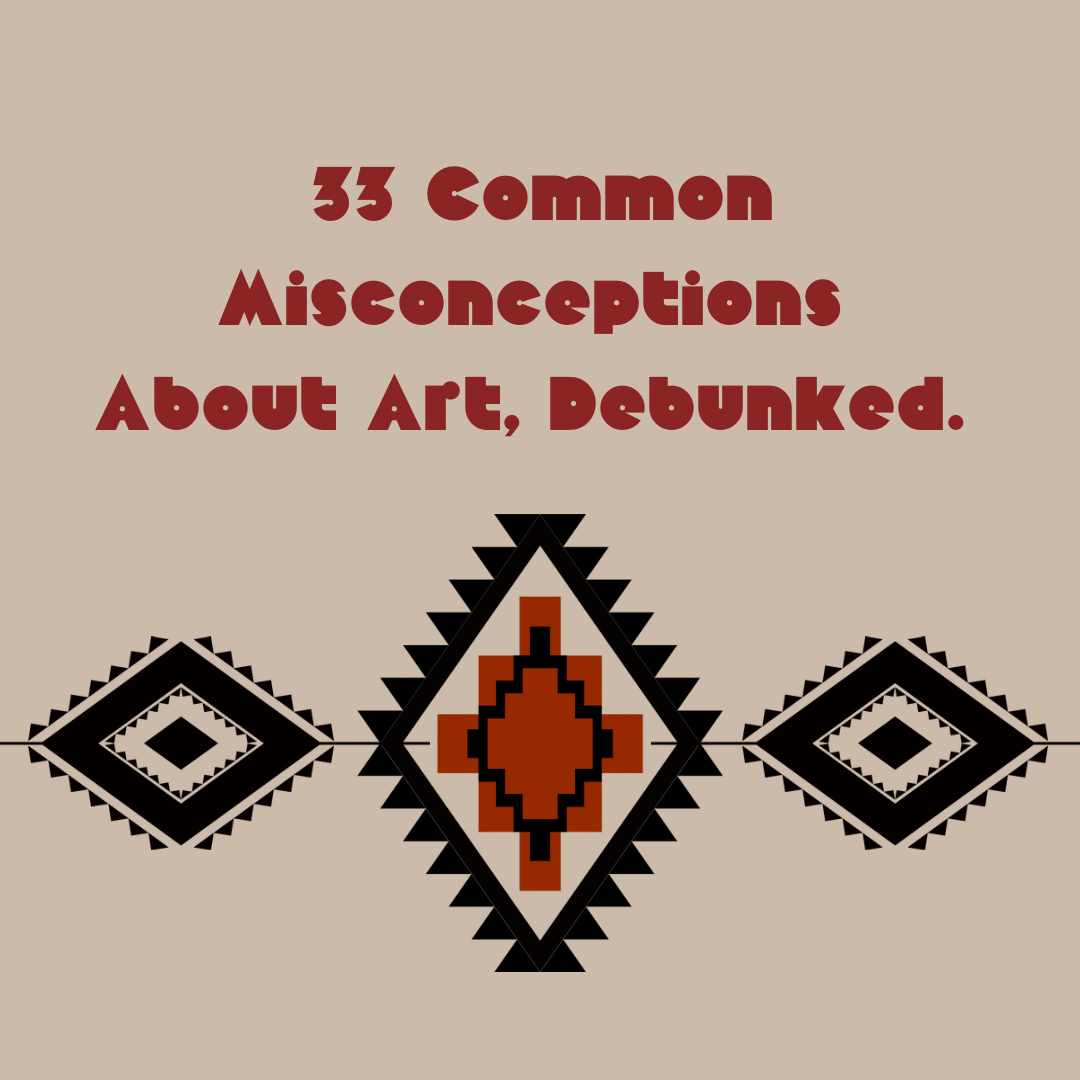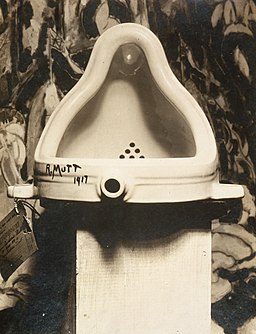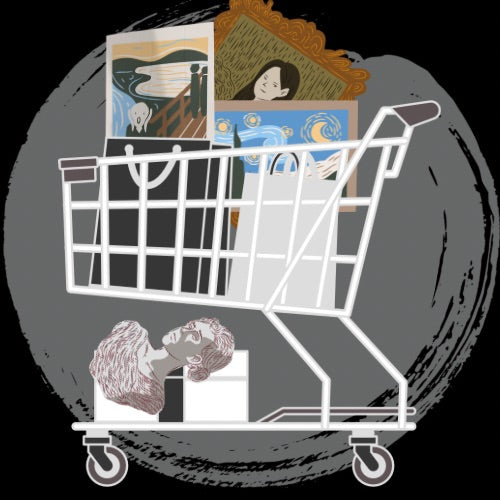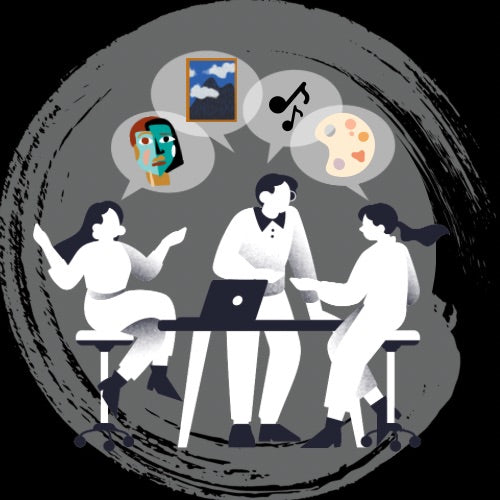
33 Common Misconceptions About Art, Debunked (With Examples)
Share
33 Common Misconceptions About Art, Debunked (With Examples)
For centuries, there have been myths and misconceptions surrounding art, the universal language and the epitome of human creativity. Today, we aim to shed light on these misconceptions, providing clarity and a deeper understanding of the art world. Debunking these misconceptions is important because they perpetuate false beliefs. They also hinder the appreciation and understanding of art.
By dispelling these myths, we can encourage a more inclusive and diverse art community, where everyone feels welcome to explore and engage with different forms of artistic expression. Ultimately, debunking misconceptions helps to demystify art and make it more accessible to all.
Ready for an enlightening exploration that strikes at the heart of these art myths? Let’s embark.
I. Misconceptions About the Purpose of Art
Art’s purpose - a question as old as time. Is it just aesthetic, or does it dig deeper into the caverns of human emotion and experience?
1. "Art is Only for the Elite":
Art is for everyone, evident in street murals, local exhibitions, and even doodles in a child’s notebook. Famed artist Jean-Michel Basquiat began as a graffiti artist in Lower Manhattan. Street murals like those in the Wynwood Walls of Miami or the East Side Gallery in Berlin make art accessible and public.
However, there are still instances where art is primarily seen as a luxury for the elite. For example, high-end art galleries and auction houses cater to wealthy collectors who can afford to purchase expensive artworks. This exclusivity can create a perception that art is only meant for those with significant financial means, reinforcing the misconception that art is solely for the elite. (Click here for unique artworks and exclusive designs for a very affordable price 😉)

2. "Art Equals Beauty":
Art challenges, provokes, comforts, and it doesn’t have to be confined to beauty. Marcel Duchamp’s “Fountain”, a urinal, challenges the very definition of art, pushing boundaries beyond traditional beauty A detailed counterexample to the perception that art equals beauty can be found in the world of contemporary and avant-garde art. Artists in this realm often challenge traditional notions of beauty, creating works that are intentionally provocative, disturbing, or unconventional. These artworks may not conform to societal standards of beauty and can be difficult for some viewers to appreciate or understand. This counterexample highlights the subjectivity of art and challenges the assumption that art is solely about aesthetic.

3. "Art Must Be Deep":
Not every piece of art carries a profound or hidden message; some are simple expressions of joy. Pop art, like the works of Andy Warhol, often exhibits everyday, simple objects, highlighting common things. The argument that art must be deep ignores the value of simplicity and the ability of art to evoke emotions beyond intellectual interpretation. One could argue that art can be deep in its simplicity, as it can provoke introspection and contemplation without relying on complex symbolism or hidden meanings. For example, the minimalist artwork of Donald Judd challenges the notion that depth is only achieved through intricate narratives or profound concepts. Instead, his simple geometric forms invite viewers to engage with the fundamental qualities of line, color, and space, encouraging a deeper appreciation for the essence of art itself.

From cave paintings to modern installations, art serves as a chronicle of human evolution, a window to our soul, and not just a piece of decoration.
II. Misconceptions Involving Artists
The enigmatic artist - often imagined as a figure brooding over a canvas. But, is there more to this character than popular culture portrays?
4. "An Art Degree is a Must":
While art education definitely adds value and essential knowledge to an artist by providing the necessary steps for their creativity, it is not the only way to become a successful artist. But many renowned artists have never attended art school. Passion and practice matter immensely. Vincent Van Gogh, Frida Kahlo, and Jean-Michel Basquiat largely self-taught themselves; they are now among the most famous artists in history. Their passion was far more pivotal than formal.

5. "Artists Must Suffer for Their Art":
While many artists have faced struggles, art can also arise from happiness and contentment. Georgia O’Keeffe’s floral paintings, teeming with vibrancy, are often the product of her sheer love for the natural world, not suffering. She found inspiration in the beauty of flowers and used her art to express her joy and connection to nature. Similarly, Henri Matisse's vibrant and colorful paintings were a reflection of his exuberant personality and love for life, rather than a result of suffering or hardship.

6. "Artists Are Born, Not Made":
While talent helps, dedication, passion, and training can shape an artist.
Frida Kahlo, after her accident, nurtured her innate talent with immense practice and dedication, evolving into an iconic artist. Throughout her life, Kahlo constantly pushed herself to explore new techniques and styles, participating in various art workshops and collaborating with fellow artists. She understood that talent alone was not enough; it was her relentless commitment to honing her craft that allowed her to create such profound and impactful artworks. Ultimately, her journey serves as a testament to the power of dedication and perseverance in becoming a successful artist.
Artists, with their diverse backgrounds and inspirations, are a testament to the fact that art isn’t bound by stereotype. Their stories are as varied as their masterpieces.
III. Misconceptions About the Value of Art
Value and art—two terms often interwoven with highbrow auction figures. Yet, there's a spectrum that remains unexplored.
7. "Museums Alone House Real Art":
Art is everywhere—from local cafes to public squares and online platforms. Banksy’s art, often painted on city walls and sidewalks, frequently sells for millions. Street art, therefore, isn’t just a form of public expression but also a testament to the value of art outside of traditional spaces. For example, a famous street artist named Shepard Fairey gained recognition for his iconic "Hope" poster of Barack Obama during the 2008 presidential campaign. Despite being created outside of traditional art spaces, this artwork became a symbol of political change and was even acquired by the Smithsonian National Portrait Gallery. This demonstrates that art can hold immense value and impact, regardless of its location or medium.
8. "Art is a Stable Career Choice Only for the Gifted":
The art world has its challenges, but dedication often outweighs raw talent. JK Rowling’s ‘Harry Potter’ series, though literature, is a testament to how persistence in the creative world can redefine perceptions of success. Despite being rejected by numerous publishers, Rowling persisted in her writing and eventually found success, proving that dedication and hard work can lead to a stable career in the arts. This counters the notion that only the gifted can have a stable career in art, as Rowling's success was not solely based on innate talent but on her perseverance and determination.
9. "Only Original Ideas are Worth Pursuing":
Art evolves. Reinterpretation and reinvention have always been part of its charm. Pablo Picasso, one of the most renowned artists ever, was known to say, “Good artists copy, great artists steal.” Hence, originality in art is about interpretation and not just inception. For example, a contemporary artist may take inspiration from Picasso's famous painting "Les Demoiselles d'Avignon" and create their own interpretation of the piece, adding their unique style and perspective. This not only adds to the ever-evolving nature of art but also showcases that originality can be found in reimagining existing

Beyond its monetary estimate, art resonates with intrinsic worth, transcending from urban murals to classic literature.
IV. Misconceptions About Art’s Interpretation
Interpretation—an intimate tango between art and its beholder. Yet, does a singular truth exist?
10. "One True Interpretation Exists":
Art is subjective. Everyone can have their own unique interpretation. Abstract paintings, such as those by Jackson Pollock, open the floor to numerous interpretations, proving that art doesn’t have a single meaning or story. For example, one person may see Pollock's painting as chaotic and messy, while another may find beauty in the patterns and colors. This diversity of interpretation highlights the rich complexity of art and challenges the notion that there is only one correct way to understand it.

11. "Deep Art Knowledge is Needed to Interpret Art":
Personal feelings and perspectives play a crucial role in art interpretation. Yoko Ono’s “Wish Tree”, an interactive piece where viewers can add their own messages, is a testament that one doesn’t need profound knowledge of art history or theory to interact with or interpret art. Visitors of all ages and backgrounds can participate in this piece and find personal significance in their own messages, showing that art interpretation can be accessible to everyone regardless of their level of

12. "If Not Understood, It’s Not Good Art":
Some artworks reveal their meanings over time, inviting viewers to return and explore. "Black Square” by Kazimir Malevich has been both lauded as a masterpiece and criticized as incomprehensible. Yet, its prominence in art history emphasizes that understanding isn’t a prerequisite for significance. For example, a novice art enthusiast may initially see "Black Square" as a simple black painting, devoid of any deeper meaning. However, upon further research and contemplation, they may come to realize its significance as a revolutionary statement in abstract art, challenging traditional notions of representation and giving rise to new artistic possibilities.

Every piece offers countless narratives, reminding us that art thrives on subjective exploration.
V. Misconceptions About Art Creation
The birth of art is a process that can be instantaneous or challenging. Let’s seperate fact from fiction.
13. "Quick Artworks Are Inferior":
Duration doesn’t define art’s quality. Some masterpieces are born in mere moments. Chinese calligraphy, with its rapid strokes and fluid motions, showcases that the duration taken to produce art doesn’t correlate with its quality or worth. For example, the renowned Chinese calligrapher Wang Xizhi is known for his masterpiece "Preface to the Poems Composed at the Orchid Pavilion", which he famously completed in a single day. Despite its quick execution, this piece is highly regarded for its elegance and skillful brushwork, proving that quick artworks can be just as profound and valuable as those that take longer to create.

14. "Digital Tools Aren’t Authentic Artistry":
Mediums evolve, but the essence of art remains unchanged. Digital artists like Beeple have revolutionized the art scene with their digital masterpieces, highlighting that digital mediums are just as authentic as traditional ones. Beeple's artwork "Everydays: The First 5000 Days" sold for a staggering $69 million at an auction, showcasing the immense value and recognition of digital art in the contemporary art world. This masterpiece, created over a span of 13 years, demonstrates the meticulous attention to detail and artistic vision that can be achieved through digital tools, debunking the notion that digital art lacks authenticity or skill.
15. "Artists Should Stick to Traditional Materials":
Innovative materials often bring fresh perspectives and possibilities. For example, El Anatsui, a renowned Ghanaian artist, challenged the notion of traditional materials by creating stunning tapestries made from discarded bottle caps. His intricate and shimmering works have gained international recognition and serve as a testament to the power of innovation in art.
Every piece offers countless narratives, reminding us that art thrives on subjective exploration.
The origin stories of art pieces are as diverse as their creators, each narrating a unique tale of inception.
VI. Misconceptions About Art’s Role in Society
Art—a mirror to society, or perhaps its compass? Delve into its multifaceted roles.
16. "Art Doesn’t Drive Change":
Art has historically influenced societal shifts by questioning norms and shaping dialogue. Chinese artist Ai Weiwei's installation "Sunflower Seeds" presented at the Tate Modern in London, raised awareness about labor conditions in China and sparked conversations about globalization and consumerism. Additionally, his work "Remembering" memorialized the thousands of children who died in the 2008 Sichuan earthquake, leading to discussions about government accountability and transparency. These examples demonstrate how art can provoke thought, challenge the status quo, and ultimately inspire social change.

17. "Art Isn’t Functional":
Functional art, like artisan furniture or crafted utensils, blurs the line between utility and beauty. The best example of this is the Bauhaus school in Germany, founded by Walter Gropius in 1919, emphasized the integration of art and design with everyday life. Their innovative approach to architecture, furniture design, and typography created functional yet visually appealing products that transformed the way people interacted with their environment. This challenged the traditional notion that art should be purely decorative and showcased how design could enhance functionality while still being aesthetically pleasing.

Art doesn't merely reflect; it instigates, critiques, and shapes societal narratives.
18. "Art Is Merely a Luxury":
Art reflects emotions, memories, and shared human experiences far beyond mere luxury. The surge in art therapy practices across the globe demonstrates the practical application and critical importance of art in mental and emotional well-being. Furthermore, numerous studies have shown that engaging with art can support cognitive development and improve brain function. Whether it's through creating art or appreciating the works of others, art stimulates different areas of the brain, encouraging creativity, critical thinking, and problem-solving skills. In this way, art is not only necessary but also integral to the growth and enrichment of the mind.
VII. Misconceptions About Artistic Freedom
The canvas of artistic freedom, vast and open, yet sometimes perceived with boundaries. Time for a deep dive.
19. "True Artists Don’t Need Validation":
Validation can inspire and motivate artists, pushing them to evolve. Salvador Dali's ventures into advertising and commercial projects emphasize that even globally renowned artists seek validation and commercial success. Dali's pursuit of validation through his commercial projects demonstrates that even highly acclaimed artists can benefit from external affirmation. Seeking validation is not a sign of weakness or lack of talent, but rather a way to fuel inspiration and growth. By acknowledging the importance of validation, artists open themselves up to new opportunities and avenues for creativity.
20. "Artists Work Only When Inspired":
Routine and discipline play a significant role alongside inspiration. Renowned artist Chuck Close's work ethic underlines the fact that consistent effort, rather than sporadic inspiration, leads to success in the art world. For example, Close's meticulous process of creating his large-scale photorealist paintings involves spending hours in his studio, meticulously working on a grid system to capture every detail. Despite any feelings of self-doubt or lack of inspiration, Close remains dedicated to his craft, demonstrating that discipline and perseverance are key factors in artistic success.
21. "Artists Should Stick to One Style":
Styles evolve as artists grow, learn, and experience. The varied phases in Picasso's career, from the Blue Period to Cubism and then to Classicism, highlight that an artist's evolution in style can be both natural and rewarding. During his Blue Period, Picasso primarily used shades of blue and depicted themes of sadness and poverty. However, as he delved into Cubism, his style became more abstract and focused on breaking down objects into geometric shapes. Finally, in his Classicism phase, he returned to more traditional and realistic forms of art. This evolution in style not only allowed Picasso to explore different artistic techniques but also helped him leave a lasting impact on the art world.
Artistic journeys vary, but the essence remains—freedom in exploration and expression.
VIII. Misconceptions About Art Education
Natural flair vs. academic rigor in art. An age-old debate with contemporary nuances.
22. "Studying Art is Impractical":
Art education nurtures creativity, critical thinking, and broadens horizons. Iconic movie directors, like Steven Spielberg and Martin Scorsese, have their foundations rooted in art and its principles, driving home the point that art education has far-reaching implications beyond the canvas. Art direction plays a crucial role in award-winning movies, as it helps create visually stunning and captivating scenes. The careful selection of colors, props, set designs, and costumes can enhance the storytelling and leave a lasting impact on the audience. This artistry is not limited to traditional paintings but extends to the world of film, where directors like Spielberg and Scorsese understand the importance of art education in fostering creativity and pushing boundaries. Debunking these reaffirms the vastness and versatility of the art world.

23. "You Can’t Teach Someone to Be an Artist":
Artistic techniques and history can be taught, complementing innate talent. The efflorescence of art during the Renaissance, supported by various art schools, disproves the notion that artistry is an innate gift that can't be nurtured or taught. Furthermore, art lessons and community support provide a platform for aspiring artists to learn and grow. By providing guidance and mentorship, artists can develop their skills and experiment with different styles and mediums. This not only helps them express their own unique artistic vision but also contributes to the overall cultural enrichment of society. Together, art education and community create a thriving environment where creativity can flourish.
24. "Academic Art Limits Creativity":
Education offers tools. Artists decide how to utilize them. Academic art, contrary to the belief that it limits creativity, actually provides aspiring artists with the necessary tools and skills to express their unique artistic vision. Through guidance and mentorship, artists can learn different techniques and experiment with various styles and mediums. By understanding the foundations of art, they are better equipped to push boundaries and create innovative works. Therefore, academic art serves as a platform for creativity to thrive, enabling artists to learn and grow in their artistic communities.

Both innate talent and formal education craft masterpieces. The art world thrives on this rich blend.
IX. Misconceptions About Art’s Accessibility
Is art an exclusive realm for the elite? Or a universe awaiting universal exploration?
25. "Art is Expensive":
Art exists across a spectrum of prices, from affordable prints to priceless masterpieces. Platforms like Etsy have democratized art, making it clear that owning art doesn't necessitate emptying one's bank account. With the rise of online marketplaces and independent artists, there are now more options than ever to find affordable and collectible art pieces. Visit our online store and get your own affordable artwork.
26. "Art Galleries are Intimidating":
Galleries are becoming more inclusive, aiming to welcome and educate visitors. Free-entry days in museums globally, like the Louvre's free first Sundays, are initiatives to make art more approachable and less intimidating. Some art galleries may have a reputation for targeting only wealthy, influential people, but this is not true for all galleries. Many galleries are becoming more inclusive and are working to make art more accessible to everyone. Initiatives such as free-entry days in museums are aimed at welcoming and educating visitors, making art less intimidating for all.
27. "Understanding Contemporary Art Requires Expertise":
Contemporary art often invites personal interpretations, making it accessible to all. The sheer popularity of public art installations, such as Chicago's "Cloud Gate", accentuates that contemporary art can be accessible, appreciated, and interpreted by people from all walks of life.
From community exhibits to global galleries, art beckons every curious soul.
X. Misconceptions About Art and Technology
The digital age meets timeless creativity. A harmonious union or a contentious overlap?
28. "Digital Art Isn’t Real Art":
All forms of art, traditional or digital, carry authentic expressions of creativity. The rise in value and acclaim of NFT-based art shatters the myth that digital art is any less "real" or valuable than traditional art. Art was painted almost everywhere. Art was painted everywhere, from cave walls to high-rise buildings. Digital art is a legitimate form of artistic expression that should not be dismissed or undermined. It embraces technology to create stunning visual experiences that can evoke emotions and spark meaningful conversations. In today's digital age, it is important to recognize and appreciate the innovative ways in which artists are utilizing technology to push the boundaries of traditional art forms.
29. "Technology is Killing Traditional Art Forms":
Technology often complements and revives traditional arts, making them more accessible. The utilization of AR technology in museums to enhance visitor experience underlines the harmonious relationship between tech and art. There are now digital canvases you can hang on your walls to display multiple artworks and digital photographs without having to print and hang each one of them. Technology added a new dimension to traditional art.

30. "Online Art Platforms Devalue Art":
Digital platforms democratize art, bringing it to wider audiences and providing artists with global exposure. Online platforms like DeviantArt and Behance have propelled many artists to fame, highlighting the role the internet plays in art appreciation and discovery.
Digital platforms and tech integrations are merely modern brushes in the ever-evolving art arsenal.
XI. Other General Misconceptions
A miscellany of myths, each adding a layer of intrigue to the art mosaic.
31. "Art Shouldn’t Be Political":
Art has been a medium for political discourse and social commentary for centuries. Politicians use art for self-promotion, communication, and propaganda. Society uses art for awareness, demonstration, and celebration.

32. "Artists Are Eccentric by Default":
Artists, like all individuals, have varied personalities. Eccentricity isn’t a given. While many label artists as "eccentric", Leonardo da Vinci's extensive notebooks demonstrate a profound balance between artistry and scientific inquiry.

33. "Art’s Value is Determined Solely by Its Price":
Price is just one aspect. The true value of art is in its expression, meaning, and impact. The sentimental value people attach to personal mementos, like childhood drawings or family portraits, goes to show that the true value of art often lies beyond its price tag.
Debunking these 33 misconceptions reaffirms the vastness and versatility of the art world.
By recognizing that art is not solely defined by its price, we open ourselves up to a world of diverse and meaningful artistic experiences. Through this understanding, we can truly embrace the power of art to inspire, provoke thought, and evoke emotions within us. Let us continue to examine and celebrate the boundless possibilities that art offers, beyond its monetary value. Dive deeper, explore, and let art touch your soul. If you wish to own a piece that resonates, explore our collection and begin your artistic journey.
Do you have any other misconceptions on your mind? Want to add your viewpoint on this topic? Share your thoughts by commenting below.
Stay curious and keep on learning.
AR.




